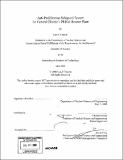Anti-proliferation safeguard system for General Electric's PRISM reactor plant
Author(s)
Tenorio, Luis E
DownloadFull printable version (13.10Mb)
Other Contributors
Massachusetts Institute of Technology. Dept. of Nuclear Science and Engineering.
Advisor
Michael Golay.
Terms of use
Metadata
Show full item recordAbstract
The proliferation resistance of a nuclear power plant has become an increasingly important issue due to the political climate of nuclear power at the present. Any new power plant that is constructed must be proliferation resistant and meet international standards set by the International Atomic Energy Agency (IAEA). In an age with a War on Terrorism and states not declaring their nuclear intentions, nuclear power needs to have proliferation resistance be a primary concern if nuclear power plants are to be built in the future. The PRISM nuclear reactor system has been examined in this work with focus on the movement of nuclear fuel. The PRISM was chosen as the system to develop a proliferation safeguard system because of the literature that has been readily available for it and its potential use in the MIT Sodium Fast Reactor project. The safeguard system is based on the CANDU safeguard system with new components included to address diversion scenarios that were developed as part of this work. This work consists of developing those scenarios and the safeguard system. Also, research into the different components has been done. Basing the system on proven work and showing that such systems can be adapted allows this system to be versatile in its use and implementation.
Description
Thesis (S.B.)--Massachusetts Institute of Technology, Dept. of Nuclear Science and Engineering, 2008. Includes bibliographical references (leaf 50).
Date issued
2008Department
Massachusetts Institute of Technology. Department of Nuclear Science and EngineeringPublisher
Massachusetts Institute of Technology
Keywords
Nuclear Science and Engineering.
